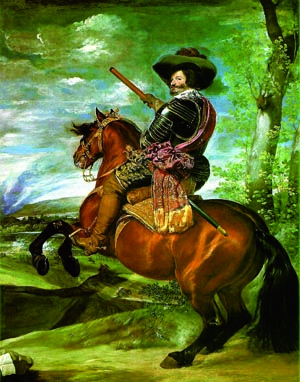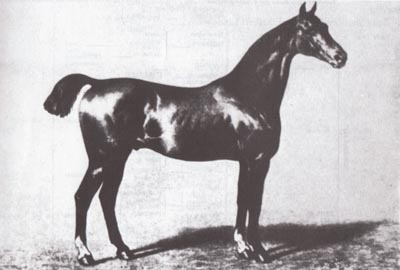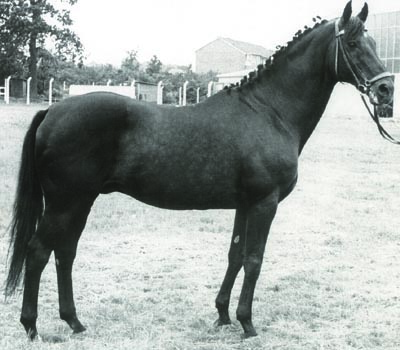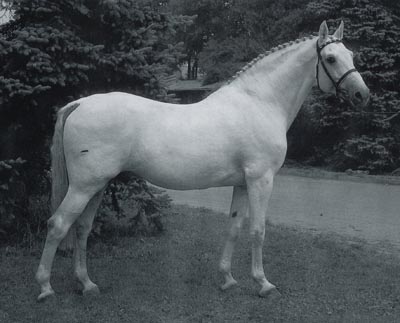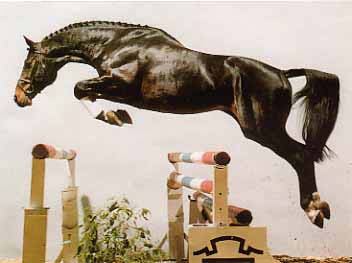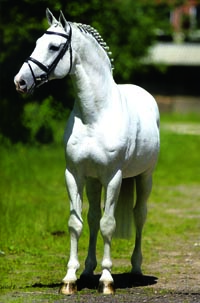A Journey through Holstein – Part Three: Coming to the end – some history, something of the future
Story by Chris Hector & Photos by Roz Neave
The nineteenth century British Prime Minister, Lord Palmerston once said that historians went mad, or to an early grave, trying to understand Schleswig-Holstein’s history, so we’ll skip the north /south divide and the 400 years of Danish rule, and cut to the chase. Very early on the horses of Holstein, thanks largely to the monks who bred them with care, became famous all over Europe.
King Philip II of Spain is said to have used nothing but Holsteiners in his stud at Cordoba, and certainly the horse in the famous painting of the King looks very like a Holsteiner.
One of the Spanish nobility in the Court for Philip – the Duke de Olivares, on what looks very like a Holstein horse…
The French King Louis XIV was another enthusiastic customer. Even the 13 founding stallions at the Hanoverian Stud in Celle, came from Holstein!
And the local authorities were quick to maintain quality standards. As early as 1719, awards were given to fine stallions owned by the farmers – but the stallions had to be between the ages of 4 and 15, at least 157.5 cm (15.2) without shoes, and have sired at least 15 foals in the previous year. Annual inspections were made and some stallions branded and permitted to breed (but not be sold) while other stallions were barred from breeding.
In the nineteenth century, the Holstein horse breeding scene was greatly shaped by three outstanding horsemen:
The Duke of Augustenburg, the economic advisor, Georg Ahsbahs and Claus Hell Sr (yes, a distant relation of the famous Maas J. Hell who shaped the modern Holsteiner). The Duke, in particular, was responsible for importing very fine Thoroughbred stallions, and encouraging the local breeders to use them. One of these stallions, Protocol (born in 1828) was to found the Ethelbert line that continues into the present day through the dam line of his illustrious descendent, Lord.
Ethelbert – in the first half of the 1950’s, 60% of the Holsteiner state stallions belonged to this line. Ethelbert was by a Thoroughbred stallion, out of a mare of Yorkshire Coach Horse breeding.
Ahsbahs and Hell were organizers as well as horsemen, forming stud books to regulate breeding. The breeding goal of the association formed by Hell was set out in 1885: “A refined, powerful carriage horse with strong bone structure and high, ground covering strides, which at the same time should possess all the qualities of a heavy riding horse.”
Ahsbahs created the Holsteiner Stud book, and crowned his activities by helping found the Elmshorn Riding and Driving School in 1894 – this was the first such institution in the world.
In 1926/7 the Federation of Horse Breeders of the Holsteiner Marshes were forced to turn over all their stallions to the State Stud… but with the onset of mechanization, the farmers abandoned their horses and by 1960, the government dissolved the State Stud. The Holstein breeders federation took over 30 Holsteiner stallions, and three Thoroughbreds. The time had come to transform the Holstein horse from an agricultural worker to an international competitor!
In 1961, the registered mare band had shrunk to 1322 – eleven years earlier, in 1950, it had been just under 10,000. The traditional agricultural role of the Holsteiner had virtually disappeared while the interest in equestrian sport – particularly in Germany – was booming.
According to Romedio Graf von Thun-Hohenstein in his book, The Holsteiner Horse: “Instead of simply giving up and allowing the breed to wither away as a victim of economic development, the dynamic Board of Directors decided to totally reshape the horse which had been entrusted to them. The work clothes and habits of the hard working rural labourer were to be traded in for the custom tailored suits and elegant manners of the international athlete. This all had to be accomplished without relinquishing indispensable physical and mental strength and natural talent of the robust country boy.”
And that transformation involved – as it had in the nineteenth century – a massive influx of Thoroughbred blood.
Cottage Son – one of the Thoroughbreds that revived the breed…
By 1976, of the top 62 class A Holsteiner stallions, 7 (12%) were Thoroughbreds, 24 (30%) were sons of Thoroughbreds, and there were three grandsons of Thoroughbreds – well over half the stallion band. Of the rest, there were three Selle Français (although two of those Selle Français, Cor de la Bryère and Silbersee were both by Thoroughbred stallions), seven sons of Selle Français (four of them by Corde), a handful of descendents of the Anglo Arab, Ramzes and just six sons of purebred Holsteiners – that’s 10% of the total! These A stallions covered 2874 mares – the breed had been saved.
Norbert Boley has been the director at Elmshorn since 1982 and freely admits that his term in office has been much less dramatic than the changes under his predecessor, Maas J. Hell.
According to Mr Boley: “The change before I came was much bigger with the introduction of a great deal of Thoroughbred blood and also, the arrival of Cor de la Bryère. In the last 25 years we have tried to bring in some new blood – like Quidam de Revel and some other French horses. But the main point of our breeding has been to produce the progress out of our own lines.”
With the emphasis always on jumping?
“Yes always jumping, but the direction changes, our horses always have good scope, but a lot has changed around. Now you still need scope, but also good style, you also need a very fast horse to win today, so we had to change our horses.”
“We have to find the right mix of all the different parts. We had the line of Ladykiller, which was very successful, we had the line of Cor de la Bryère, which was very good, Ramiro – little bit more on the mother’s side because he produced much better on the female side than the males. What was coming up, was the line of Capitol. We had to find the right mix.”
Capitol – sheer power and a mainstay of modern jumping breeding…
You had to refine the Capitol line?
“Yes, when I started in Elmshorn, Capitol was only four years old, so it was interesting to see how we could use this stallion. He gave real scope, simple horses, and that was good for the market, and good for the sport results. So now you see that balance in a stallion like Cassini who is one of the most important stallions this year in our country, and he is well-known all over the world. He had two winners at the WEG in Aachen, with Berlin and Cumano. He is by Capitol, but out of a mare by the Cor de la Bryère son, Caletto – and also with the Thoroughbred blood of Marlon.”
Cor de la Bryère provided a balance to Capitol, a little more careful?
“It’s a very good balance to the horses we had before. If you take a look at Eurocommerce Berlin, he is by Cassini but the mare is by Caretino, that’s Cor de la Bryère’s line – a lot of good horses have Cor de la Bryère on the mother’s side – Caretino, Caletto II, it’s a really good cross with the line of Capitol.”
And the next line comes from Quidam?
“It’s a good new line we can use. It is our problem that we only have a few lines, so it is our business to bring some new blood into our breed. We tried to do it with Thoroughbreds, but it is not so easy. We did it with one Anglo Arabian stallion, Bacchus, he was a good horse in sport and he created a new line and we have tried to continue that with other Anglo Arabian and Thoroughbred stallions. With Quidam we have a horse with a lot of blood, a fast horse, not always very easy to handle. In our breeding mares, we have a good rideability so I think it is not a problem.”
Do you think the Holsteiner horse has become more pretty?
“Yes, it’s a change. Twenty five years ago the horses were bigger and heavier, so we tried to change the type. The breeder knows very well what sells on the market, and they have their eye on the international scene, and they find the way to bring up the right horse for the market, that is good for the riders.”
In Hanover, it is hard to get the breeders to use the older stallions, but in Holstein it is hard to get them to use the younger stallions…
“It’s a big difference. The market in other breeding areas is much more in the direction of dressage and they can easily sell the foals – they are very pretty and with big movement. In our area, the people prefer to breed jumpers, and if the product has a really good pedigree, it’s a good selling point. The movement is not so important, they believe much more in the breeding lines. If there is a foal from Contender or Capitol, or ten years ago, by Landgraf, then there is a pretty good guarantee that the foal will be a jumper, and that creates the market. It is not possible to do it with a young stallion, no one knows about his progeny. That’s the difference between our breeding area and others.”
Contender – all the mare owners want to breed to him…
You encourage the breeders to use the younger stallions – if they want to breed to Contender, they have to also breed to a younger stallion…
“There is a great deal of interest in using the older stallions, it’s nearly a guarantee to make money if you breed a foal by one of them, so all the breeders want to use these stallions. So we made a combination that also gives us a chance to bring the young stallions into the breeding system, at the moment it works well, it is now accepted because if we have no way to bring up the young stallions, we have no chance of producing top stallions for four or five years time.”
“It was the same discussion ten years ago when we had Cor de la Bryère, Lord and Landgraf as the three heroes, and everyone was asking, ‘what happens after these three stallions?’ We had to work to bring up some young stallions, but it was successful. Today, the breeding situation is more extreme than it was ten years ago – with artificial insemination it is a different situation now, we have to be careful that we don’t have just three or four stallions in our breeding area, so that we have good young ones for the future.”
The number of mares a stallion can have is limited?
“At the moment it is 350 for the old ones. The stallions have to show us that they have good offspring, not just one outstanding foal, before we let them cover many mares. We are always working in relation to our not very big mare band – in Hanover it is nearly 20,000 mares, here it is 7,500, so it is a different world for us, we have to be careful. Also from the point of view of marketing, it is more interesting if every year there are 250 foals from Contender or Cassini, so that there is a good market for them. If there are 500 or 700, there is not so much interest. How many mares the young stallion breeds depends on their performances. After their performance test, they start with 80 and as they get older they can cover 150, then the big step is to 350 but that is just a few stallions.”
If we think of Capitol as being power, and Cor de la Bryère being careful, where does Contender fit in – what does he bring to the breeding mix?
“He has all the good blood in his pedigree. He has Cor de la Bryère, he has Ladykiller, he has Ramiro. I think he is able to do everything – he produces good horses with quality, scope – he is somewhere between the two, the mix. He is not as big and as strong as Cassini, but he has good performance and produces good rideability. There are a lot of good offspring from him in the market, the Contender offspring move better than those from Cassini and Capitol.”
He still lives in a traditional little stallion station attached to a hotel?
“There is a special reason for that. A few years ago we had a big problem with EVA, and he is the last who survived from that group with EVA, so we cannot keep him with the other stallions, it’s not allowed. So he lives the traditional life in Haselau.”
The rest of the stallions are at Elmshorn?
“We have only five stallions at different stations for live covering, but the breeder usually prefers to use artificial insemination. In the last 25 years, there has been a big change. Once all the stallions were natural covering at one place, now they can do their job at 17 or 20 places in our area. We still have the breeding stations all over the country, but nearly 50 stallions are based at Elmshorn – they are collected there, and the semen sent to the breeding stations. It’s a good way to manage it, the breeders always have access to fresh semen, and it is much easier to get the mares in foal than it is with frozen semen – and at the same time, we can have a good training system for the stallions, we exercise them regularly. We try to keep the stallions sound so they can breed for a long time, and it is much better to have control over all the stallions in one place than in 17 different places, where someone has to run around all those places trying to control the whole system, it’s much easier.”
Are you still basically a geographically based stud book?
“Yes. Our idea is that we first have to do a good job for our breeders in our area but in the last few years, we get more and more members in other breeding areas of Germany, and elsewhere in Europe, especially Belgium and The Netherlands. Also in Denmark – but that is historic, there has always been a good connection with Denmark. It is now a question of the law in Germany, now we have to work with people who want to breed Holsteiners in other parts of the European Union, so we have to open our system – but our main interest is to have a good breeding system for our breeders in our district here.”
You have a relationship with the American Holsteiner breeders?
“That is also an historic thing. Thirty five years ago there was one person in the United States, he had an arrangement with our Verband at the time, but we had problems with that whole system, and came to an arrangement with the association the USA – we are connected but they have their own system to select and breed. Our breeding area is very different from the USA, it doesn’t work to try and use our system there. In the USA, the distances are so big, it’s the same as we learnt in another big country – Australia – it’s not possible to have one place where the mares and foals are selected because the people have to come from so far away. Here it is very simple, there are ten places in our area, and there are always 60 to 100 three year old mares at one place. But it is not possible to do that in the United States, for example.”
So you came to Australia but you don’t have a relationship with the Australian Holsteiner breed association?
“They are doing their own business. They are working in the same system to select the mares and stallions but it is not controlled by us and they have their own life. They get some support from us but they have to create their own system in their own country – they have to find what will work. We cannot transport our system to other countries and say you have to do it exactly the way we are doing it here.”
You are happy with the direction of the current breeding policy – no big changes in the next 20 years?
“We have to follow the Government rules and work with breeders in the other areas, that’s for us a big change because in history we have always said – that is our breeding area, and we are working in this area, and we have a permit from the government to operate in Schleswig-Holstein and not more. At the moment if you have a mare and you want her selected for our studbook, then you have to come here in our district. It’s the only way to get mares into our book. Also we accept only our bloodlines – we don’t accept Hanoverian mares, or Westfalien, or Oldenburg mares. They have to have our bloodlines otherwise they have no chance to get into our studbook. That is very different from the others – and for sure, our idea is to continue this way because we are not interested in having a big number of members or a big number of mares. We would like to breed in our system with our lines and not with different breeding ideas.”
“There will be changes, you always have to follow what happens in the sport. If the sport asks for a horse with more scope, then we have to breed this kind of horse. If they like to have a very quick horse, then we have to meet the market. You have to see what is happening in the world, and have horses for this market.”
Do you see the future in Holstein still based on the farmer with half a dozen mares, as part of a total agricultural mix – or will we see more studs with just horses?
“We would prefer to have the traditional farmer because it is easier for them to breed horses as part of their business. If they only have horses then there is a big financial pressure. When they have different sectors in their economy, they can always have good times in one part and bad times in another. To do only horse breeding, then the breeders have to have a really good system, and they have to use the right stallions, and have good management – otherwise it is very hard to make money only out of horses.”
Are there more private stallions now than when you started?
“The number of private stallions is growing, but the percentage of covering by our stallions, owned by the association, remains the same. We cover between 60 and 70%, we have 5000 breedings a year with our stallions. That’s okay, I think it is a good situation. In the beginning there was a very hard situation between the private stallion owners and our association, but now there is a big change, and we can talk with the private stallion owners. It’s good to have competition, it’s good for the market, it’s good for the breeder. If we are alone on the road, it’s not so good, and not so interesting for the breeders. The way we are working and talking together is much better than in the past when we were always fighting and there were personal problems, but this time has gone.”
Cassini – keeping the best stallions for the Holstein breeders
Do you see the Thoroughbred and Arab blood continuing to have an influence in your breeding program?
“We use the Thoroughbreds and the Anglo-Arabs to firstly create new lines, and also to have the possibility to change the type a little. It’s my personal idea that we have to have a horse with all the scope, light enough and easy enough, and so we have to use a little bit more the Thoroughbreds without losing the rideability and the scope that we have. That is not so easy but we have to find the right way.”
And you guard the stallions for your breeders?
“Yes, for example when Cassini was just eight years old, Mr Melchior said whatever you want, I will buy him. But no, it is important that our breeders know that we take care of their interests, that we don’t sell the good stallions no matter how much money we are offered. Unlike some other breeding associations, our stallions are owned by the association, they are not part of a state stud – that makes us closer to the breeders.”
It really is amazing, that in a globalised world, the breeders of Schleswig-Holstein continue to pursue horse breeding goals that are centuries old, but goals that are shaped by the competition requirements of tomorrow.
Thank you, to all who helped us on our journey, in particular Donata von Preußen, who set up the stud visits, accompanied us on our travels, acted as interpreter, and then put up with my interminable requests for further information…
Footnote:
A familiar face at Elmshorn….
They are all over Germany, young Australian riders with a passion to learn in this the home of equestrian sport… but they are more often dressage riders, than jumper. Brooke Campbell is therefore something of an exception, since she has found her way to Holstein, working in the Breeding Centre at Elmshorn, helping work the young auction horses, and learning from the master trainer, Peter Luther in the process.
“I came here for about seven months ago, riding six horses a day. My visa ran out after three months but they offered me a position, so I could come back for another six months. That was too good an opportunity to miss.”
“At the moment I am helping out with one of the other rider’s horses, she hurt her shoulder, so I am riding eight to twelve horses a day – it keeps me busy.”
Is the approach very different from Australia?
“Yeah especially with my horses – I’ve only ever had Thoroughbreds and Stock Horses, so riding the Warmbloods is a very different world for me. The riding techniques are different because they are a different style of horse, but it’s very good.”
“Luckily there’s a lot of people here that speak English, I am very fortunate there.”
Since then, Brooke has returned to Australia – with a head full of jumping ideas from the home of jumping horses, Holstein…




